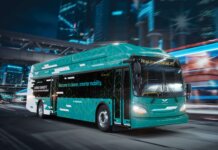On Thursday, Southern California Gas Co. (SoCalGas), in collaboration with a number of partners, held a public exhibition of projects to help California achieve greenhouse-gas (GHG) emission reductions.
The California utility held the event at the San Diego State University Center for Energy Sustainability in Brawley, Calif.
One project was a solar thermochemical advanced reactor system (STARS). Results from extensive testing show that STARS produces hydrogen from sunlight at record levels of solar-to-chemical energy conversion efficiency. By reacting water with methane, which provides an energy boost, the compact (measuring just a few cubic feet) modular system produces about 15 times more hydrogen than a combination of photovoltaics and electrolysis for the same amount of solar energy, says SoCalGas.
Initial planned applications include locating STARS systems at fueling stations to produce low-cost hydrogen for fuel cell vehicles. Transportation accounts for about 40% of California’s GHG emissions, the utility notes. Zero-emission vehicles, like those powered by hydrogen fuel cells, can help achieve emissions reductions.
“The deployment of fuel cell vehicles has been slowed by limited availability of low-cost hydrogen at filling stations,” says Robert Wegeng, president of STARS Technology Corp. and a former technology developer at the Pacific Northwest National Laboratory. “Combining concentrated solar energy with advanced chemical process units plus water and low-cost, carbon-lean natural gas provides a near-term opportunity for cheap hydrogen at the locations where it is needed. This gives fuel cell vehicles an opportunity to compete in the marketplace and will help California achieve its goals of net-neutral carbon emissions by 2045, net-negative afterwards.”
In addition, the Hyperlight system, operating at the Center for Energy Sustainability, is a concentrated solar power (CSP) technology that uses sunlight to produce heat for industrial processes. Water-filled trays support low-cost, linear solar reflectors that aim sunlight onto a heat-receiving element. Currently, the Hyperlight technology is working in conjunction with Genifuel’s hydrothermal processing (HTP) technology, which uses heat and pressure to convert wet organic matter, such as manure, algae and biosolids, into renewable natural gas (RNG). In this project, the heat is supplied by the sun through the Hyperlight system. It is a highly efficient process, capturing 86% of the energy in the waste and using only 14% to process it, says SoCalGas.
“Hydrothermal processing converts wet waste materials into renewable oil and natural gas, directly offsetting the use of fossil fuels,” says James Oyler, president of Genifuel Corp. “There are enormous amounts of these materials which would otherwise degrade the environment instead of contributing clean, renewable energy. This project shows how the process could benefit California’s dairy industry by converting dairy cow manure into renewable fuels.”
The projects, which have received funding from SoCalGas, the California Energy Commission and the U.S. Department of Energy, support the commercialization of low-cost, commercial-scale renewable energy technology that can help California achieve its climate goals.






